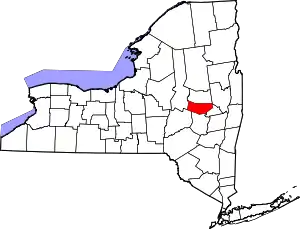Amsterdam (city), New York
Amsterdam is a city in Montgomery County, New York, United States. As of the 2010 census, the city had a population of 18,620. The city is named after Amsterdam in the Netherlands.
Amsterdam | |
|---|---|
 The Sanford Clock Tower, built in 1922 | |
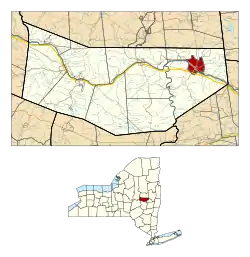 Location within Montgomery County and the state of New York | |
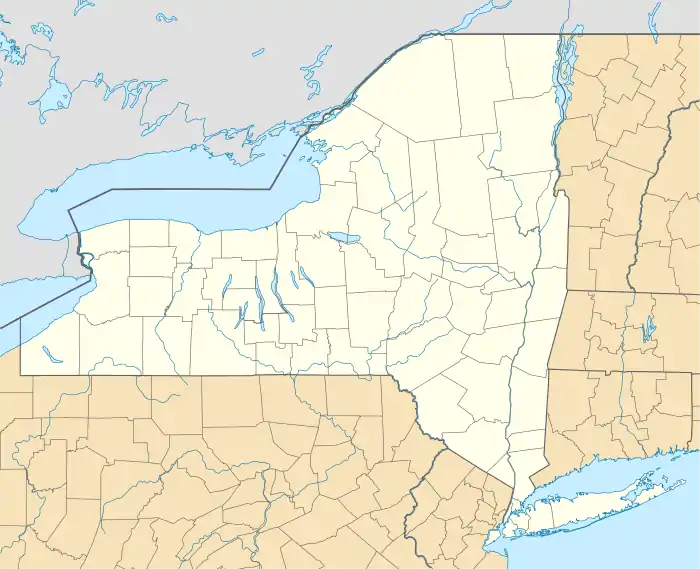 Amsterdam Location in New York  Amsterdam Amsterdam (the United States) | |
| Coordinates: 42°57′N 74°11′W | |
| Country | United States |
| State | New York |
| County | Montgomery |
| Incorporated (village) | 1830 |
| Incorporated (city) | 1885 |
| Government | |
| • Type | Mayor-council |
| • Mayor | Michael Cinquanti (D) |
| • City council | Members' List
|
| Area | |
| • Total | 6.26 sq mi (16.21 km2) |
| • Land | 5.87 sq mi (15.21 km2) |
| • Water | 0.39 sq mi (1.00 km2) |
| Elevation | 361 ft (110 m) |
| Population (2010) | |
| • Total | 18,620 |
| • Estimate (2019)[2] | 17,766 |
| • Density | 3,025.54/sq mi (1,168.13/km2) |
| Time zone | UTC−05 (Eastern (EST)) |
| • Summer (DST) | UTC−04 (EDT) |
| ZIP code | 12010 |
| Area code(s) | 518 |
| FIPS code | 36-02066 |
| GNIS feature ID | 0942450 |
| Website | City of Amsterdam website |
The City of Amsterdam is surrounded on the north, east, and west sides by the town of Amsterdam. The city developed on both sides of the Mohawk River, with the majority located on the north bank. The Port Jackson area on the south side is also part of the city.
History

Prior to settlement by Europeans, the region which includes Amsterdam was inhabited by the Mohawk tribe of the Iroquois Confederacy, having pushed the Algonquin Mohican tribe across the Hudson River. Dutch settlers began to arrive in the area in the 1660s, founding Schenectady in 1664, and arrived in what would later be Amsterdam c.1710. They called the community Veeders Mills and Veedersburgh after Albert Veeder, an early mill owner. In the early 1700s, Scotch-Irish and German Palatinate immigrants began to arrive in the Mohawk Valley region, but few settled in Amsterdam, instead going further west.[3]
The American Revolutionary War had little effect on the Amsterdam region. No major battles were fought there or in the surrounding region, with the exception of the Battle of Johnstown, which was essentially the repelling of a raid by British forces and their Native American allies.
The settlement grew slowly in this period, primarily providing the services needed for the farming communities which surrounded it.[3] It was located in the now-defunct town of Caughnawaga,[4] but when the town of Amsterdam was created, the city changed its name to Amsterdam in 1803, possibly to encourage its selection as the seat of the town's government.[3]
After the War, Loyalists like the powerful Johnson family fled to Canada, and many new settlers came from New England.[4] The settlement was incorporated as a village on April 20, 1830, from a section of the Town of Amsterdam. This was a period of rapid growth for the village. In turn, the Mohawk Turnpike, the Erie Canal, and the coming of railroad service improved trade, and the steeply descending creeks were used to power an increasing number of mills, which in turn provided materials to make manufactured goods which were shipped by land, canal and rail. Products such as linseed oil, brooms, knit ware, buttons, and iron goods came out of the growing village, making it an important manufacturing center. It was best known, however, for its carpets, eventually becoming the carpet and run manufacturing center of the U.S.[3] Through the late 19th and early 20th centuries it was a destination for immigrants from Europe: Irish, Italian, Polish, and Lithuanian people, among others, who found worked in the factories.
In 1865, the population of Amsterdam was 5,135.[4] New charters in 1854, 1865, and 1875 increased the size of the village. In 1885, Amsterdam became a city, which subsequently increased in size by annexation of Rockton to the north, with the former village of Port Jackson on the south side of the Mohawk River becoming the fifth ward of the city. By 1920, the city's population was 33,524.
In the Great Depression the mills slowed down their output, but did not close, and the city survived the two world wars without significant effect. Shortly after World War II however, manufacturing in general began to move to the southern United States, where costs – including wages and taxes – were lower, and the mills of Amsterdam were no exception. One by one, they moved south or overseas. Additionally, the second and third generations of the city's immigrant families often left to go to college and did not return, as there were few jobs to attract college-educated citizens. The city attempted to re-create its industrial base, but these efforts were not particularly successful.[3]
Subsequent city and State projects for urban renewal further eroded the local character. As the city's website expresses it:
In an attempt to draw people and business back to Amsterdam, the City and State began a program of urban renewal and arterial roadway construction, destroying much of the original fabric of downtown. Now, not only is there less to go downtown for, it's harder to get there. Once again, Amsterdam is somewhere to be bypassed on the way to somewhere else.[3]
In the 21st century, post-industrial Amsterdam is still trying to re-invent itself.[3]
Amsterdam experienced serious flooding damage in the aftermath of Hurricane Irene in late August 2011. The flooding threatened properties at the river's edge due to erosion and water damage.[5]
Geography
According to the United States Census Bureau, the city has a total area of 6.3 square miles (16.3 km2), of which 5.9 square miles (15.4 km2) is land and 0.3 square miles (0.9 km2) is water, with the total area being 5.41% water. The city developed on both sides of the Mohawk River and Erie Canal, and both North Chuctanunda Creek and South Chuctanunda Creek flow into the Mohawk at Amsterdam.
New York State Route 30, a north-south highway called Market Street in part, crosses the Mohawk River to link the main part of Amsterdam to the New York State Thruway. NY-30 also intersects east-west highways New York State Route 5 and New York State Route 67 in the city. New York State Route 5S passes along the south side of the Mohawk River.
Amsterdam is currently within New York's 20th congressional district.
Economy
In the 19th century, the city of Amsterdam was known for carpet, textile, and pearl button manufacturing. It continued to be a center for carpet-making in the 20th century, when the Bigelow-Sanford and Mohawk Mills Carpet companies both were located in Amsterdam, but these companies have relocated to other regions. Amsterdam was also the home of Coleco, makers of the ColecoVision, Cabbage Patch Kids and the Coleco Adam. Founded in 1932 as the Connecticut Leather Company, Coleco went bankrupt[6] in 1988 after a failed attempt to enter the electronics market, and pulled out of Amsterdam, as well as its other North American manufacturing sites.
The enclosed shopping center is named the Amsterdam Riverfront Center. Once filled with clothing shops, the mall complex has been adapted for offices of doctors, public assistance services, community organizations, a radio station WCSS, and an off-track betting site.
| Historical population | |||
|---|---|---|---|
| Census | Pop. | %± | |
| 1840 | 1,700 | — | |
| 1850 | 2,000 | 17.6% | |
| 1860 | 2,044 | 2.2% | |
| 1870 | 5,426 | 165.5% | |
| 1880 | 9,466 | 74.5% | |
| 1890 | 17,336 | 83.1% | |
| 1900 | 20,929 | 20.7% | |
| 1910 | 31,267 | 49.4% | |
| 1920 | 33,524 | 7.2% | |
| 1930 | 34,817 | 3.9% | |
| 1940 | 33,329 | −4.3% | |
| 1950 | 32,240 | −3.3% | |
| 1960 | 28,772 | −10.8% | |
| 1970 | 25,524 | −11.3% | |
| 1980 | 21,872 | −14.3% | |
| 1990 | 20,714 | −5.3% | |
| 2000 | 18,355 | −11.4% | |
| 2010 | 18,620 | 1.4% | |
| 2019 (est.) | 17,766 | [2] | −4.6% |
| sources:[7][8][9] | |||
Media in Amsterdam includes one print newspaper, The Recorder, which is owned by the Schenectady-based Daily Gazette,[10] an online newspaper, The Mohawk Valley Compass, and two AM radio stations, WVTL and WCSS.
In the early 2000s distribution centers began being constructed in the Florida Business Park in the Town of Florida which is located just outside the City of Amsterdam. The park currently holds Target, Hill & Marks, Alpin Haus, and most recently, Dollar General. In 2019 Vida Blend broke ground on a new distribution center in the park. Some thousands of city and adjacent county residents are now employed by these businesses.
Demographics
As of the census[9] of 2010, there were 18,620 people, 8,324 households, and 4,721 families residing in the city. The population density was 3,176.4 people per square mile (1,226.4/km2). There were 9,218 housing units at an average density of 1,573 per square mile (607/km2). The racial makeup of the city was 80.4% White (68.1% Non Hispanic White), 3.8% Black or African American, 0.6% Native American, 0.9% Asian, 0% Pacific Islander and 3.4% from two or more races. 26.2% of the population were Hispanic or Latino of any race.
There were 8,146 households in the city, with the average household size being 2.24 persons. In the city, 25.0% of the people were under the age of 18 and 15.8% were age 65 or older.[9] The median income for a household in the city, based on data from 2007 to 2011, was $38,699.[9]
Transportation
Amsterdam is at the convergence of State Routes 5, 30 and 67. The New York State Thruway/Interstate 90 is a little less than a mile to the southwest of the city.
Three Amtrak trains stop at Amsterdam Station in each direction daily:
- The Maple Leaf, operating between Toronto Union Station, and New York Penn Station
- Two Empire Service trains, operating between Niagara Falls and New York Penn Station
Sports
- Amsterdam's municipal golf course was designed by Robert Trent Jones.
- The city is home to the Amsterdam Mohawks baseball team of the Perfect Game Collegiate Baseball League. The team plays at Shuttleworth Park.
- The Professional Wrestling Hall of Fame was located in Amsterdam until November 2015, when it relocated to Wichita Falls, Texas.
Places of interest

- The Mohawk Valley Gateway Overlook pedestrian bridge spans the Mohawk River and connects the city's Bridge Street downtown area on the south shore and Riverlink Park on the north. It was built from 2014 to 2016.
- Lock E11 was built to facilitate water traffic on the Mohawk River/Erie Canal; it is one of 8 locks which include a truss structure which spans the river and which has multiple steel gates which can be opened and closed by the use of electric winches in order to dam the river or let it flow freely.
- The Sanford Clock Tower, also known as the Sanford Mills, the Hasbro Plant, the Coleco Industries Plant – where Cabbage Patch Dolls and ColecoVision were manufactured in the 1970s and 1980s – and, currently, the Clock Tower Complex, was built in 1922 for carpet magnate Stephen Sanford as the headquarters and mill of the Sanford-Bigelow Carpet Company. The current owners, who bought the property in 2001, hope to attract small businesses and professional as well as manufacturing and warehousing businesses to the building.[11][12][13]
Although ill-considered urban renewal highway projects did significant damage to the city's historic downtown,[3] a few historic buildings and sites, mostly from the 19th and 20th centuries, remain in the city, and are listed on the National Register of Historic Places (NRHP):[14]
- Amsterdam (46th Separate Company) Armory was built in 1895 as an armory for the New York Army National Guard and was decommissioned in 1994. It is now a bed and breakfast inn called the Amsterdam Castle;
- Amsterdam City Hall was built in 1869 as the residence of carpet magnate Stephen Sanford. In 1932 it was deeded to the city to become its city hall;
- the Amsterdam Free Library is a Carnegie library which was built in 1903;
- the Gray-Jewett House, was built in 1890;
- Green Hill Cemetery;
- the Greene Mansion was built in 1881;
- Guy Park Manor was built in 1774 in the Georgian style for Guy Johnson, the Irish-born nephew and son-in-law to Sir William Johnson, 1st Baronet, the British Superintendent for Indian Affairs in colonial New York. It replaced an earlier house which burnt down. The house and the land it is located on sustained significant damage from Hurricane Irene; the house is located in close proximity to Lock E11;
- the Guy Park Avenue School was built in 1902 and ceased being used as a school in 1968;
- Samuel Sweet Canal Store was built in 1847 to service barges on the Erie Canal as both a store and a forwarding warehouse;
- the Saint Stanislaus Roman Catholic Church Complex contains a church (1897, enlarged 1912), a school building (1906, closed in 2011), a former convent, now the parish center (1934) and a rectory (1941);
- the Temple of Israel is a synagogue built in 1901;
- United States Post Office built in 1936; and
- Vrooman Avenue School, built in 1916 and ceased operating as a school in 1975; it is now an apartment building.
The Chalmers Knitting Mills was added to the NRHP in 2010,[15] but was later demolished.
Houses of worship

- Calvary Assembly of God (Pentecostal)
- Kingdom Hall of Jehovah's Witnesses
- Congregation Sons of Israel (Jewish)[16]
- Covenant Presbyterian Church
- Crossroads Community Church (independent)[17]
- Five Buddha Temple
- First Baptist Church of Amsterdam[18]
- First Reformed Church
- Goddess of Mercy Temple (Buddhist)
- Iglesia de Dios, Torre Fuerte (Hispanic Pentecostal)
- Lord of the Harvest Church (Non-denominational)
- Our Lady of Mount Carmel (Catholic)
- Pilgrim Holiness Church
- Salvation Army
- Segunda Sinagoga (Pentocostal)
- Seventh-day Adventist Church
- St. Ann's (Episcopal)
- St. Luke's (Lutheran)
- St. Mary's (Roman Catholic)
- St. Nicholas (Ukrainian Catholic)
- St. Stanislaus (Roman Catholic)
- The Time for Truth
- Trinity Lutheran
- United Presbyterian Church
Education



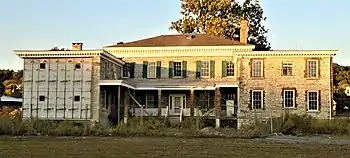

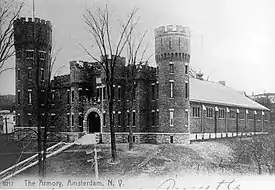
Public schools
Elementary
- William H. Barkley Elementary[19]
- William B. Tecler Arts in Education Magnet School[20]
- Marie Curie Institute of Engineering & Communications[21]
- Raphael J. McNulty Academy for International Studies and Literacy[22]
Secondary
Private schools
- St. Mary's Institute
Library
The Amsterdam Free Library at 28 Church Street is a Carnegie library built in 1902-1903 with $25,000 from philanthropist Andrew Carnegie. It was designed by Albert W. Fuller in the Beaux-Arts style.
Government
Amsterdam's government consists of a city council and a mayor. The mayor is elected in a citywide vote. The council consists of five members each elected from wards.
Mayors
| Name | party | Year(s) |
|---|---|---|
| Carmichael, John | 1885 | |
| Kline, Harlan P. | Rep. | 1886 |
| Liddle, Thomas | 1887–88 | |
| Dwyer, John F. | 1889 | |
| Waldron, Hicks B. | 1890 | |
| Breedon, William A. | 1891–92 | |
| Nisbet, Charles S. | 1893 | |
| Hannon, George R. | 1894 | |
| Fisher, William A. | 1895–96 | |
| Kaufman, William H. | Rep. | 1897 |
| Westbrook, Zerah S. | Dem. | 1898–99 |
| Wallin, Samuel | Rep. | 1900–01 |
| Gardner, William A. | Dem. | 1902–03 |
| Pabis, David R. | 1904–05 | |
| Dealy, Jacob H. | Dem. | 1906–09 |
| Conover, Seely | Rep. | 1910–11 |
| Dealy, Jacob H. | 1912–13 | |
| Cline, James R. | 1914–17 | |
| Conover, Seely | Rep. | 1918–19 |
| Akin, Theron | Rep., Dem., Soc. | 1920–23 |
| Salmon, Carl S. | Rep. | 1924–29 |
| Gardner, William A. | 1930–31 | |
| Brumagin, Robert B. | Rep. | 1932–33 |
| Carter, Arthur | Dem. | 1934–43 |
| Lynch, Wilbur H. | Rep. | 1944–45 |
| Hand, Joseph P. | Dem. | 1946–47 |
| Deal, Burtiss E. | Rep. | 1948–55 |
| Martuscello, Frank J. | Rep. | 1956–57 |
| Gregg, Thomas F. | Dem. | 1958–59 |
| Martuscello, Frank J. | Rep. | 1960–63 |
| Breier, Marcus I. | Rep. | 1964–67 |
| Gomulka, John P. | Dem. | 1968–79 |
| Villa, Mario | Rep. | 1980–87 |
| Parillo, Paul | Dem. | 1988–91 |
| Villa, Mario | Ind. | 1992–1995 |
| Duchessi, John M. | Dem. | 1996–2003 |
| Emanuele, Joseph | Rep. | 2004–2007 |
| Thane, Ann M. | Dem. | 2008–2015 |
| Villa, Michael | Rep. | 2016–2019 |
| Cinquanti, Michael | Dem. | 2020-Incumbent |
Notable people
Notable natives or residents of Amsterdam include:
- Gary Aldrich, FBI agent assigned to the White House under Presidents George H. W. Bush and Clinton; author of a book about the Clinton administration
- Bruce Anderson, Medal of Honor recipient, American Civil War soldier
- Benedict Arnold (1780–1849), United States Congressman from New York[25]
- Felix Joseph Aulisi, New York Supreme Court Justice, Appellate Division
- Josh Beekman, former National Football League offensive guard (Chicago Bears)
- Benjamin Paul Blood, inventor, poet, and philosopher
- Matthias J. Bovee, United States Congressman from New York[25]
- Roger Bowman, professional baseball player
- Lucille Bremer, actress
- Tim Buckley, musician
- Dr. Tom Catena, physician, humanitarian
- Todd Cetnar, played professional basketball in the United Kingdom
- William B. Charles, former US Congressman
- Jessica Collins (Birth name: Jessica Capogna), actress
- Charles Dayan, United States Congressman from New York and former Lieutenant Governor of New York[25]
- Kirk Douglas, actor
- Arlene Fontana, singer and actress, known for her appearances on various prime-time variety shows in the 1960s and early 70s[26][27]
- Mary Anne Krupsak, New York State Lieutenant Governor
- John Henry Manny, inventor of the Manny Reaper
- H. Edmund Machold, Speaker of the New York State Assembly
- Chris Marcil, television producer, writer, and actor
- George Miles, Michigan Supreme Court justice
- Marilyn Hall Patel, federal judge for United States District Court for the Northern District of California, vacated the conviction of Fred Korematsu of the 1944 Supreme Court ruling in Korematsu v. United States
- Rocco Petrone, Apollo program director
- Todd Pettengill, former professional wrestling show host and announcer for World Wrestling Entertainment.
- David Pietrusza, author, historian
- Homer P. Snyder, former US Congressman
- Vernon Tichenor, Wisconsin State Assemblyman
- Ray Tomlinson, implemented the first person-to-person network email
- Paul Tonko, Congressional Representative from New York, former New York State Assemblyman
- Beth Van Duyne, Congressional candidate from Texas, former mayor of Irving, Texas, and former HUD official
- Samuel Wallin, former US Congressman
- Harrison Wilson, Jr., American educator and college basketball coach who served as the second president of Norfolk State University from 1975–1997.
- Ruth Zakarian, Miss New York Teen USA 1983, Miss Teen USA 1983
References
- "2019 U.S. Gazetteer Files". United States Census Bureau. Retrieved July 27, 2020.
- "Population and Housing Unit Estimates". United States Census Bureau. May 24, 2020. Retrieved May 27, 2020.
- "History of Amsterdam, NY" City of Amsterdam website
- Hamilton Child, History of Amsterdam, New York; Syracuse, New York 1869 Archived 2013-02-01 at Archive.today
- Leyden, Liz (September 1, 2011) "Manor That Has Stood for Centuries Teeters in Storm's Wake" Archived 2016-12-30 at the Wayback Machine, The New York Times
- Feder, Barnaby J. "Coleco Fails To Fend Off Chapter 11". nytimes.com. Archived from the original on 16 December 2017. Retrieved 1 May 2018.
- "Amsterdam, New York (NY 12010) profile: population, maps, real estate, averages, homes, statistics, relocation, travel, jobs, hospitals, schools, crime, moving, houses, news, sex offenders". www.city-data.com. Archived from the original on 14 August 2017. Retrieved 1 May 2018.
- https://www.census.gov/prod/www/abs/decennial/
- "Amsterdam, New York (city)" Archived 2012-06-18 at the Wayback Machine QuickFacts page from the U.S. Census Bureau's American FacFinder. Accessed: May 21, 2012
- https://www.recordernews.com/news/local-news/171226
- "Cock Tower Complex Emporis
- Becker, Tom (July 8, 2016} "Clock Tower owners hope to turn old Coleco offices into business incubator" Mohawk Valley Compass
- Hornbeck, Leigh (January 13, 2015) " Cool spaces: Diamond in the rough" Albany Times-Union
- "National Register Information System". National Register of Historic Places. National Park Service. March 13, 2009.
- "National Register of Historic Places Listings". Weekly List of Actions Taken on Properties: 1/10/11 through 1/14/11. National Park Service. 2011-01-21. Archived from the original on 2014-08-18.
- Congregation Sons of Israel Archived October 8, 2007, at the Wayback Machine
- "Archived copy". Archived from the original on 2010-10-20. Retrieved 2014-01-06.CS1 maint: archived copy as title (link)
- First Baptist Church of Amsterdam Archived May 30, 2013, at the Wayback Machine
- William H. Barkley Elementary Archived May 24, 2007, at the Wayback Machine
- William B. Tecler Arts in Education Magnet School Archived November 23, 2008, at the Wayback Machine
- Marie Curie Institute of Engineering & Communications Archived October 28, 2007, at the Wayback Machine
- Raphael J. McNulty Academy for International Studies and Literacy Archived September 14, 2007, at the Wayback Machine
- Wilbur H. Lynch Literacy Academy Archived December 12, 2007, at the Wayback Machine
- Amsterdam High School Archived December 11, 2007, at the Wayback Machine
- Who Was Who in America, Historical Volume, 1607–1896. Chicago: Marquis Who's Who. 1963.
- "Ed Sullivan delighted with singer Arlene Fontana". The Daily Gazette. Retrieved February 7, 2020.
- "Arlene Fontana IMDB". Retrieved February 7, 2020.
External links
| Wikimedia Commons has media related to Amsterdam, New York. |


